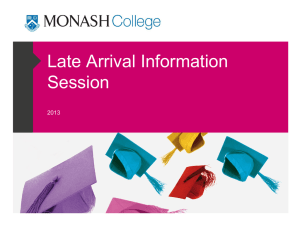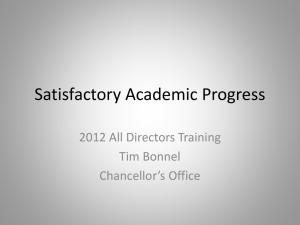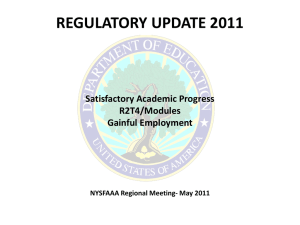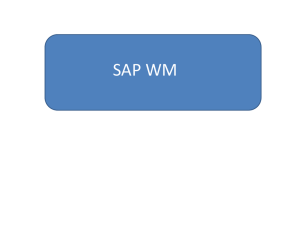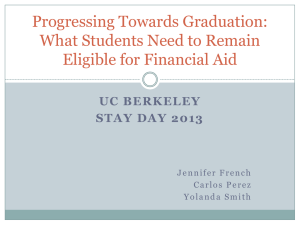Financial Aid issues in a Competency-Based Education
advertisement
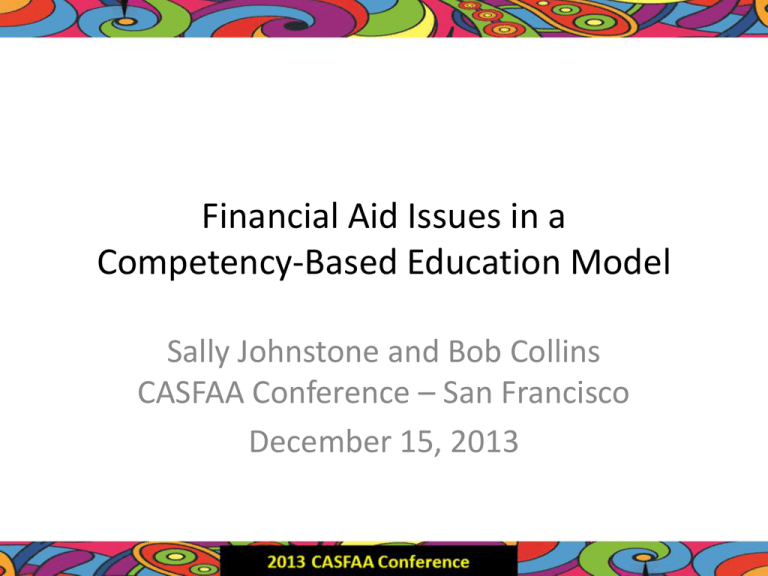
Financial Aid Issues in a Competency-Based Education Model Sally Johnstone and Bob Collins CASFAA Conference – San Francisco December 15, 2013 Competency-Based Education Sally M Johnstone Vice President for Academic Advancement Western Governors University Western Governors University Founded in 1997 The principal mission of Western Governors University is to improve quality and expand access to post-secondary academic opportunity by providing a means for individuals to learn independent of time or place and to earn competency-based degrees and other credentials that are credible to both academic institutions and employers. Where are we now? Colleges: Information Technology, Business, Teacher Education, and Health Professions Students are full-time, degree seeking at Baccalaureate and Masters level Current enrollment > 40,000 Most successful students – start with some college experience have work experience motivated to earn degree average age is 37 years Critical Elements of WGU Model for Student Success Faculty/Mentors Critical Elements of WGU Model Learning materials -leverage buying power -tracking student use Critical Elements of WGU Model Assessments -mapped to competencies -secure Growing Interest in CBE Carnegie Foundation for the Advancement of Teaching re-examining the ‘Carnegie Unit’ Foundations working with regional accreditors and Dept of Ed to assure financial aid for CBE Gates Foundation supported project includes WA, IN, FL & TX colleges as partners Adapting and Adopting Competency-Based IT Instruction to Accelerate Learning funded by DoL’s (TAACCCT) Partner Colleges Developing CBE Programs Austin Community College, TX Broward College, FL Sinclair Community College, OH FL – Valencia College IN – Ivy Tech Community College (Ft Wayne & Lafayette) TX – Lone Star Community College WA – Bellevue College, Columbia Basin College, Edmonds Community College, Community College of Spokane Design Principles for CBE 1. Degree reflects robust and valid competencies. 2. Students are able to learn at a variable pace and are supported in their learning. 3. Effective learning resources are available to students anytime and are reusable. 4. The process for mapping competencies to courses/learning outcomes/assessments is explicit. 5. The assessments are secure and reliable. Financial Aid Issues Bob Collins Vice President Student Financial Aid Western Governors University WGU Background • HEA Reauthorization 1998 – eligible institution • Distance Education Demonstration Program – Competency-based Model • Education Domains • No Grades (Narrative Transcript) • Unbundled Faculty Model (Mentoring) – – – – – Direct costs only in cost of attendance calculation Non-Term (6 month payment periods) SAP 100% Term Students start 365 days a year 100% Distance Education WGU Background • Lessons Learned – – – – – – – Introduction of Competency Units (CUs) Non-Standard Term – borrower based academic year 6-Month Terms begin on the first of each month Grades of Pass and Not Pass 66.67% Cumulative Satisfactory Academic Progress (SAP) Flat term-based tuition that encourages acceleration Cost of Attendance – EFC = Need (Sub/Unsub eligibility) • Veterans Benefits and State Funded Student Assistance • Consult state agencies Measurement of SAP Competency Based Model • Degree Plan • Academic Activity Verification (AAV) • Qualitative Measure (Pass = B or better) – Mastery of subject mater • Quantitative Measure – Attempted versus completed • SAP appeal approval requires Academic Plan • On-Time Progress (OTP) to Graduation – At least 12 CUs per six month term SAP Overview • • • • • Financial aid only awarded up to 150% of the program length At least 66.67% Cumulative SAP = Good Standing Less than 66.67% Term SAP = Warning New students less than 3 CUs per term = Terminated SAP Appeals – Extreme Medical, Loss of Job, Disability, Death • Documentation & Situation Improvement • Unintended consequences • Meeting OTP in a term does not necessarily mean the student is meeting cumulative SAP requirements • 12/20 = 60.00% - OTP is good, SAP is bad - discouraging Other Regulatory • Definition of Credit Hour 34 CFR 600.2 – www.ifap.ed.gov Hot Topics - Program Integrity • Distance Education Definition 34 CFR 600.2 – …support regular and substantive interaction between students and faculty • Direct Assessment 34 CFR 668.10 – DCL GEN-13-10 (March 19, 2013) • Return to Title IV (R2T4) – Academic Related Activity 34 CFR 668.22(l)(7) 34 CFR 668.22(l)… (7)(i) “Academic attendance” and “attendance at an academicallyrelated activity”— (A) Include, but are not limited to— (1) Physically attending a class where there is an opportunity for direct interaction between the instructor and students; (2) Submitting an academic assignment; (3) Taking an exam, an interactive tutorial, or computerassisted instruction; (4) Attending a study group that is assigned by the institution; (5) Participating in an online discussion about academic matters; and (6) Initiating contact with a faculty member to ask a question about the academic subject studied in the course; and 34 CFR 668.22 (l)(7)… (B) Do not include activities where a student may be present, but not academically engaged, such as— (1) Living in institutional housing; (2) Participating in the institution's meal plan; (3) Logging into an online class without active participation; or (4) Participating in academic counseling or advisement. (ii) A determination of “academic attendance” or “attendance at an academically-related activity” must be made by the institution; a student's certification of attendance that is not supported by institutional documentation is not acceptable. Determining Last Date of Attendance (LDA) • Institution required to take attendance? • www.ifap.ed.gov Program Integrity Q&A: R2T4 – TA-Q2: If an institution monitors whether its online students log into classes, is this an institution that is required to take attendance? – TA-A2: No. The monitoring of whether online students log into classes does not by itself result in an institution being an institution that is required to take attendance for Title IV, HEA program purposes. If, however, the monitoring of student activity is tracking academic engagement, then the institution would be an institution that is required to take attendance for Title IV, HEA program purposes. Student Fraud Considerations • WGU Orientation – Begins the 15th of each month – Setting proper expectations – academic and financial • Delay disbursement for ALL new students – 30 day delay (45+ days of academic effort before $$$ ) • Duplicate address reports (US and E-mail, IP) • Third party identity management/biometrics • Verification of identity – new in 2013-2014 – Notarized statement of educational purpose Questions and Comments


